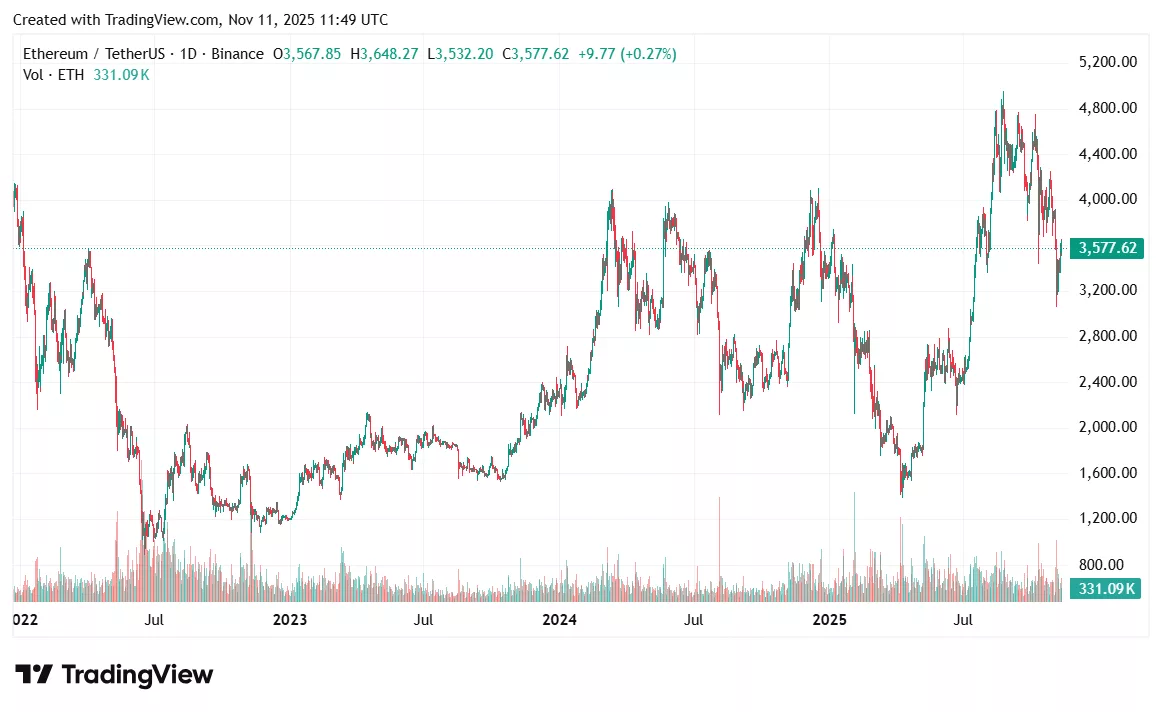Ethereum price prediction: Is a volatility squeeze building below $3,600?
- Ethereum price is expected to consolidate around $3,580 within a range of $3,500 to $3,680.
- Bollinger Bands are tightening, and intraday fluctuations are minimal, indicating a compression of market volatility.
- Despite price stagnation, stablecoin inflows and Layer-2 activity (Arbitrum, Optimism) continue to be robust.
- A volatility squeeze toward $3,650–$3,700 could be triggered by a break above the $3,600 resistance.
- A decline to $3,430–$3,380 is possible if the $3,500 support is not maintained.
- Forecast for ETH overall: neutral to optimistic, pending evidence of a breakout.
With intraday swings constrained and volatility minimal, the Ethereum price is trading in a tight coil around $3,580. Major price trackers reflect the muted rangebound action and slight 24-hour drift.
Short-term charts show the price trading within a roughly $3,500–$3,680 band, and market participants are waiting to see whether a squeeze under the $3,600 region translates into a dramatic expansion move, a development closely watched in the context of the latest Ethereum price prediction.
Table of Contents
- Ethereum price scenario on November 11th
- Staking inflows could boost Ethereum price
- Fakeout may be on the horizon for ETH
- Ethereum price prediction based on current levels
Ethereum price scenario on November 11th

Micro-level volume has decreased, and on-chain signs show that stablecoin flows into the Ethereum ecosystem are increasing along with persistent Layer-2 involvement. This liquidity backdrop has the potential to both support corrections and enhance breakouts.
Early November reports show an increase in stablecoin supply on Ethereum and increasing throughput on Arbitrum and Optimism, suggesting that capital is staging on-chain despite price consolidation.
Technically, Bollinger Bands and associated volatility bands are contracting while ETH is positioned on several timeframe charts slightly below important short-term moving averages. This is a classic compression that frequently precedes a larger directional move.
Because false wicks and volatility spikes are frequent when the market re-prices rapidly, traders should handle intraday breakouts or breakdowns from this compressed environment with wider-than-normal stops.
Staking inflows could boost Ethereum price
If Layer-2 throughput keeps improving and staking inflows stay constant, a clear breach over the $3,580–$3,600 corridor will probably shift the intraday narrative toward a volatility squeeze that might push ETH into the $3,650–$3,700 range, as the next important zone is the $3600 resistance on Ethereum (ETH).
The case for a prolonged run higher rather than a short squeeze fade would be strengthened by ongoing institutional interest, ETF/flow activity into ether products, and whale accumulation concentrated around $3,500.
Fakeout may be on the horizon for ETH
On the other hand, if $3,500 is not defended, it opens the door to $3,430–$3,380, which is where previous intra-month support and liquidity pockets are located. Long-term periods of low volatility sometimes result in dishonest fakeouts; add the potential for a resurgence of Bitcoin’s dominance or a macro risk-off period, and ETH’s attempts to rise could be swiftly stopped or reversed.
As proximate risk controls, market participants should keep an eye on dominance and macro headlines to refine their ETH forecast.
Ethereum price prediction based on current levels
The tactical range is $3,500–$3,600, given the current squeeze; a breakout above $3,600 targets $3,650–$3,700, while a breakdown below $3,500 might result in a decline into the $3,380–$3,430 region. Structurally, the picture is neutral to optimistic; consistent staking and L2 activity offer a positive foundation.
However, the immediate result will depend on which side can mobilize liquidity fastest when volatility returns, a key point for traders evaluating the next Ethereum price prediction trajectory.
Disclosure: This article does not represent investment advice. The content and materials featured on this page are for educational purposes only.
You May Also Like

Best Cryptos To Buy Compared: PEPE, WIF, BONK and Avalon X

Paydax (PDP) Lending Introduces New Way To Earn With Crypto – Here’s How To Get Started
